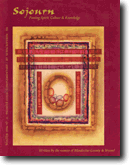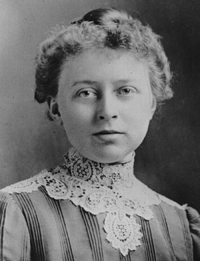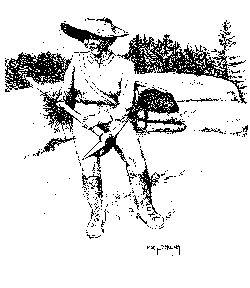SOJOURN MAGAZINE
PREMIER ISSUE
Winter 1996-1997
Winter is here and long slanting lines of rain, topped by the white mist-that means snow up there-veil the High Country from Round Valley so far below. All the streams are running bank full, and there is snow on the heavy timber. Through field glasses on bright days I can see those tall pines bent over by the weight of the snow. The bears are all denned up and the deer have all come down to the lowest foothills. Only the coyote and the mountain lion patrol that far wilderness now. Just now I am feeling very snug & warm and indifferent to the lure of the trails but I know that when the long warm days of late spring come, and feed begins to get good in the mountains, my friends tell me how the redbells are blooming just below that patch of snow in the low gap, my horse and mule, Glory and Mandy, will come in off the range and be fitted to new shoes, my camp outfit will be overhauled and as soon as we are reasonably sure of settled weather, my Indian packer Ace and I will start out again. Just here, Memory says sternly to me: "I thought you said never again when you were so fed up with dust and heat and rattlesnakes?" Says myself to me, exercising the feminine privilege of changing my mind, "Oh yes, but that was last summer-1928." I fell in love with the mountains of Mendocino, the redwoods and the open range. Three years into this century I arrived here when this was still wild country with Indians living all about-bear, mountain lion, fox, bobcat, fish, deer and coon-and the wild flowers-especially the lilies. This was around the time President Theodore Roosevelt set aside 1 1/2 million acres in Mendocino and neighboring counties as National Forest to protect them from exploitation by the lumber syndicates. President Roosevelt and I happened to share old Dutch ancestry. When he was governor of New York we often shared conversations in the public elevator of the State Capitol Building in Albany. He used the public one as his private elevator was balky. I was in Library School a few floors below his office, concentrating on Indian Languages. Around me in the State Library reading room were the life-sized portraits of the treaty chiefs of the Five Indian Nations. Having been born in the Hudson Valley-Mohawk Country-I wanted to know about those lives and their intricately organized societies where women held high places. I was preparing for my second choice of career. I'd have been a physician, but my relatives were horrified at the prospect that I might have to give a man a bath. My mother died at my birth, February 10, 1879. I was especially told that my accomplishments must be such as would justify the sacrifice of her life. My father, who died when I was 14, encouraged me to read widely. I was allowed unusual outdoor freedom. I always dreamed of living with the Indians. In 1902, I crossed the country by rail to be a librarian at the University of California at Berkeley. I soon overdid my eyesight cataloguing foreign language books and taking classes. I was told to rest my eyes and went up to the redwoods near Sherwood, just north of Willits. There I met two young bachelor girls. We decided to take up adjoining homesteads. My 160 acres was astraddle two creeks-Dutch Henry and Long Valley. We felt very primitive and pioneerish. There were no roads, just trails. The county road to Laytonville was six miles away. According to custom, I married a neighboring homesteader. Our first baby, Margaret, was born in our cabin. She slept in a basket made after her birth by my Pomo friend, Steve Sherwood. Among the Mendocino Indians, the men wove the cradle baskets of silver-leafed willow. They were called seKAH. The deer ate two little orchards we planted so we learned from our Indian neighbors to live off native plants and game without depleting the species of either. At that time, the salmon ran up the river. I could never catch one with a hook, but I could get on my bald face pony and ride him bareback into the deep pools where the salmon were stacked up like cord wood, and spear them as they came over the riffles. The Indians taught me how to bake them in slow coals, first taking out the black strip along the backbone, wrapping the chunks in cabbage leaves, then covering it all up with blue clay from the creekbed. In an hour we would crack the package with a stone, the skin would stick to the cabbage leaf and all was steam cooked. The Indians used so many plants for their survival-blue camass bulbs, the potato-like bulbs of Brodiaea, and for greens, the leaves of the yellow cowslip, watercress and the montia known as miner's lettuce. There are tangy, wild onion, wild berries, rich sweet pine nuts and grass seed for Indian cereal. Periodically an Indian family from up the mountain would walk down to help with the washing. The mother, Lucy, taught me how to gather the basket material at hand on every streamside and hillside-hazel brush, the small parts of wild grapevines, roots of willow and conifers and the sedge called Carax mendocinoensis, or the Pomo name, ka-HOOM, water gift. After two years, my marriage not being a success, I left the homestead. I rode the six miles by trail to Sherwood Valley where I lived for 2 years until I moved to Santa Rosa-just a week before the great earthquake of 1906. There I met and married Sanford Lee Redwine of one of Round Valley's old pioneer families. For the next two years I was commissioned to collect the best of Northern California Indian basketry for the University of California. Mrs. Phoebe Hearst knew of my work at Berkeley and wanted these masterpieces not to be lost as the improvements and cultivations of civilization literally uproot their sources. Sanford and I moved back north and I worked on a ward at Mendocino State Hospital at Talmage, to be near my daughter Margaret, who was confined for the violent emotional illness that struck her before she was two. My 11 happy years with Sanford Redwine ended with his death in August 1917, the same year Margaret died. Before the year was over I married Will Murphey, with whom I had worked at the hospital. We lived on a lonely ranch-Hidden Valley-two miles beyond Covelo toward the mountains. Between chores I sought rare flowers as eagerly as a book collector seeks rare volumes. The higher and more remote their habitat, the more I prized them. My neighbors, ranchers and range riders, smiled tolerantly at my enthusiasm, and at the carefulness with which I wrote down flower locations in my notebook.
When Will Murphey died of sunstroke in 1925, Campbell, the Sherwood Pomo who saved my life some 20 years before in the flood that drowned my colt and marked my daughter's mind, came to me at Hidden Valley, saying "You are all alone here. In the middle of your 40 acre field I will put a stake. You tie a white rag to it. If you need help I will come." Until I could sell the ranch, I had to stay there. Ace Hoaglen, a Wailaki boy of 12, helped me with the chores. Between Ace's knowledge of native plants, and my own daily study of Dr. Willis Linn Jepson's Manual of the Flowering Plants of California, I was ready for the high country. At first Mr. Purdy laughed outright at this 5 foot tall, 48 year old person who asked him for the job of collector in the National Forest. "A woman work for me? I can hire all the men I want. But I do need a cook." So I became his housekeeper during the winter, free to range the mountains spring through fall. It was a liberal education. Mr. Purdy is sought after as a speaker at universities and scientific gatherings near and far. When M. Henri Carrevon came from Switzerland to see the Purdy Alpines and discuss a new book, they were handicapped by neither being able to speak the other's language. Mr. Purdy was not in the least embarrassed to call on the cook to halt biscuit and gravy making to interpret. The French I had picked up as a tiny tomboy at convent school in Montreal sufficed. I had a horse and burro, and I kept my saddles and other rigging. The territory I proposed cruising is that portion of the Coast Range in the extreme northeastern corner of Mendocino County where it borders on Tehama, north and east of Round Valley, west of Sacramento Valley. Part of this territory is on deeded land on the Round Valley Indian Reservation. The flora here varies according to the elevation, from 1350 feet at Covelo, to almost 6800 feet at Buck Rock between Mendocino and Tehama Counties. This area has never been botanized. And it seems to me that transplanting bulbs and seeds will conserve rare species now being devastated by grazing, logging and wildfire. As there are no roads where I proposed going, all necessities have to be carried on pack animals. A mule can carry approximately 200 pounds, a horse less. I usually take grub for 2 for 10 days, blankets, bulb boxes, tools and camp outfit. By the time the boxes are full of bulbs and roots, and the food is running low, we are on our way home, or ought to be. Sometimes, when digging is exceptionally good, I stay out longer, having supplies sent out to me courtesy of a local pack train. They also bring my mail and newspapers. This is rendered possible by the fine telephone service on the Covelo district of the National Forest. It certainly gives one a sense of security to take down the receiver from a phone on a sugar pine 40 miles from nowhere. Frequently I am asked if I am not afraid to travel alone. Candidly, I am not. My temperamental but surefooted mule, Mandy, knows where the trail is better than I do. She is as good as a watchdog when varmints are about. I am afraid of getting lost, but the only time I ever got lost was when I had the discretion to have Ace with me. Ace is the ideal camp companion. He is cheerful, unhurried and resourceful. He has perfect camp manners and will eat anything. He firmly refuses to let me help him dig or catch the horse or help with the pack. "No use keeping a dog and barking yourself" is his motto. Ace always builds a big supper fire, for it is cold in the high hills when the sun goes down, and bright among my memories are our evenings of card games, song and story. He insisted on hearing me sing. His favorite was "Hot Time in the Old Town Tonight" and when I suggested that no one had ever wanted to hear me sing before, he said earnestly: "That's allright, Big Boy, I know all your songs got the same tune, I just wanted to learn the words, that's all." Ace showed me many of the Indian's uses of the forest's resources: how to use shinleaf pyrola for poultices; how to peel cascara bark for physic (you must always peel it towards the ground or it will nauseate you); how a certain wild iris has two fibers in each leaf that can be drawn out and woven into string; how to wash clothes; cure poison oak and stun fish in a pool with soap root. Ace showed me the lichen which grows on firs and is used for dying yellow, and the paintstone, redder than anything but blood, formerly used for ceremonial decoration. He insisted he could smell a rattlesnake, and when I laughed at him, he showed me the snake and killed it. There are relatively few dangers on long lonely trips, the principal one being the chance of inadvertently stepping on a rattler, a real danger in my case because the places I frequent in my search for lilies the cool damp willow thickets and tiny swamps around the heads of springs which are ideal summer resorts for Mr. Snake on a hot day. Hot rocky points are also good places to mind your step. Tiger lilies grow in beds or up and down the banks of streams. Some of the bulbs are shaped like your hand, some like starfish, and all have joints where they can be separated without injury. I am proud to say that I have never dug lilies without replanting. I trim and sort my bulbs on a piece of canvas and all broken or damaged bulbs, scales or pieces are carefully saved, broadcast on smoothed-over ground, covered with earth to the original depth and tramped in vigorously. In two or three years this bed may be dug up again, unless the sheep-those hoofed locusts-have eaten them down. I do not always find what I'm looking for. I have gone out on many a wild goose chase, remembering ruefully the directions old "Goodboy Jack" gave me to find the rare bright blue Mertensia, which Ace calls "don't forget-me-not." He told me it was "Way up mountain, dis side, down 'nother side, too many mile." But I always find something just a little further on. Liz Helenchild researched and wrote this piece using
the original wording of the author as much as possible. Liz Helenchild
came to Mendocino from Texas via Berkeley in 1973. Radio deejay, writer
and illustrator, she can be heard as "Late Night Liz" and "B-Side Herself"
with tunes and tales, on KMFB 92.7/96.7 FM Tuesday, Wednesday and Thursday
evenings from 8 to midnight. Table of Contents for This issue
|


 Edith Van Allen Murphey (1879-1968) came to Mendocino
County from New York via Berkeley in 1903. The young librarian-linguist
homesteaded a wilderness plot at Sherwood where she befriended her Native
neighbors. As a Covelo resident during the Great Depression, she acted
in behalf of impoverished Native people in Round Valley. From 1925 to
1935 she lived with eleven tribes as the United State Indian Service's
only range botanist. She spent the rest of her action-packed 89 1/2 years
chronicling, collecting, advocating, & preserving Native American culture,
from basketry to recipes. A self-taught ethno-botanist, Murphey compiled
the Stockman's Pocketbook, A Manual of Poison Plants, and the book Indian
Uses of Native Plants, published by the Mendocino County Historical Society,
which is still in print. She died at home in Covelo.
Edith Van Allen Murphey (1879-1968) came to Mendocino
County from New York via Berkeley in 1903. The young librarian-linguist
homesteaded a wilderness plot at Sherwood where she befriended her Native
neighbors. As a Covelo resident during the Great Depression, she acted
in behalf of impoverished Native people in Round Valley. From 1925 to
1935 she lived with eleven tribes as the United State Indian Service's
only range botanist. She spent the rest of her action-packed 89 1/2 years
chronicling, collecting, advocating, & preserving Native American culture,
from basketry to recipes. A self-taught ethno-botanist, Murphey compiled
the Stockman's Pocketbook, A Manual of Poison Plants, and the book Indian
Uses of Native Plants, published by the Mendocino County Historical Society,
which is still in print. She died at home in Covelo.  Meanwhile, I got in touch with Carl Purdy, Mendocino's
"lover of lilies." His botanical gardens, the Terraces, above Ukiah, are
famous worldwide. With great patience and for many years he answered my
queries about unusual flowers, and sent me minute instructions for collecting
and packing such bulbs as I could reach from home.
Meanwhile, I got in touch with Carl Purdy, Mendocino's
"lover of lilies." His botanical gardens, the Terraces, above Ukiah, are
famous worldwide. With great patience and for many years he answered my
queries about unusual flowers, and sent me minute instructions for collecting
and packing such bulbs as I could reach from home.